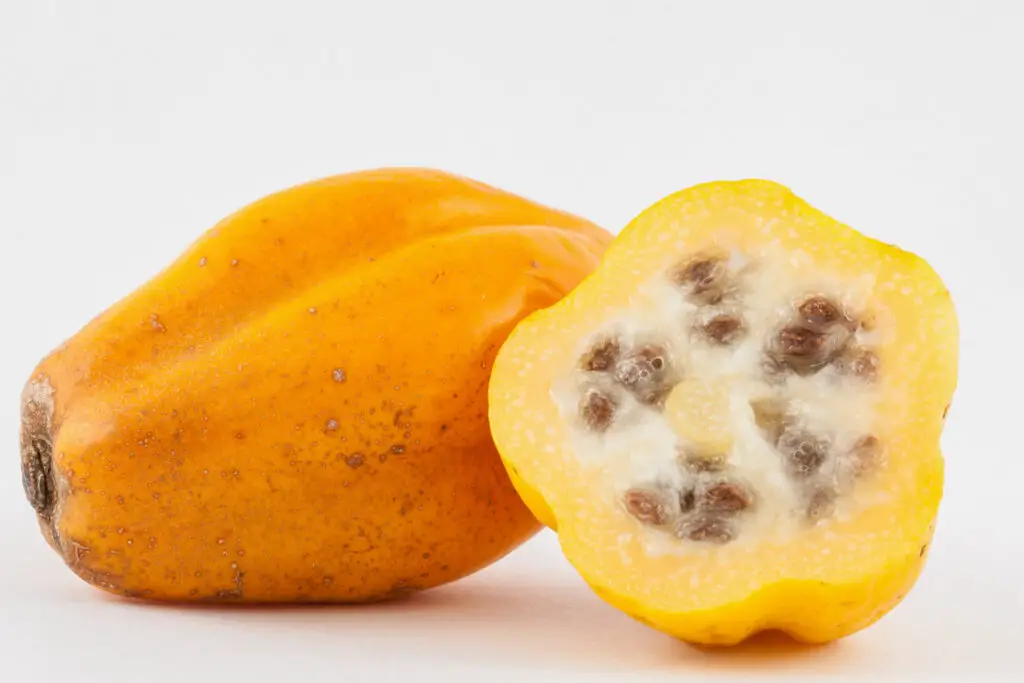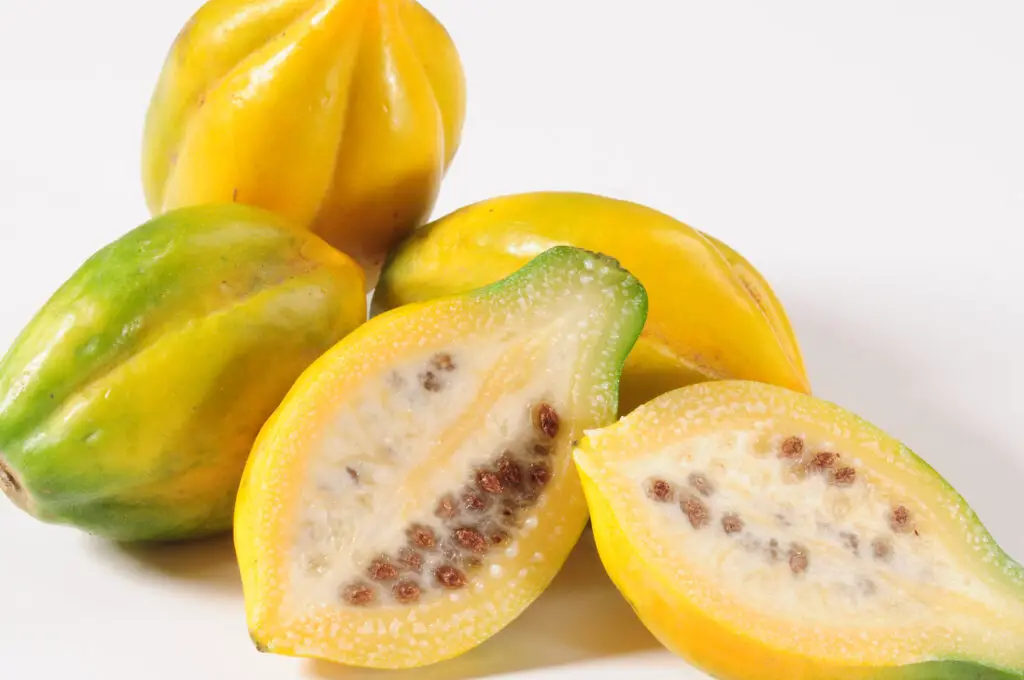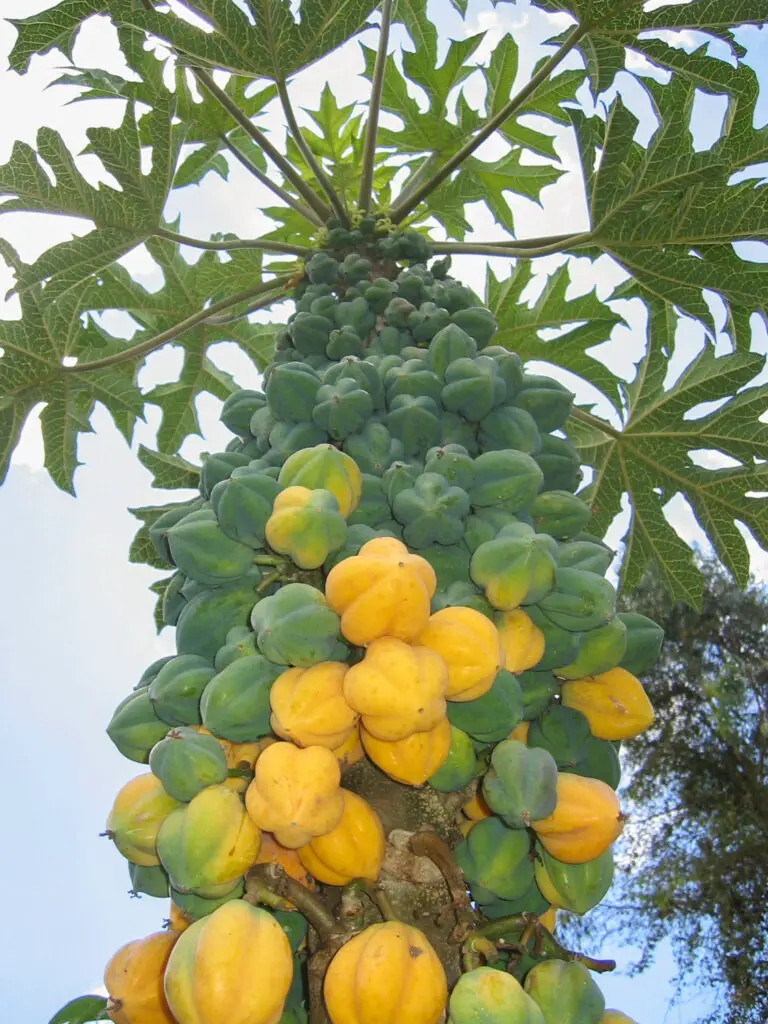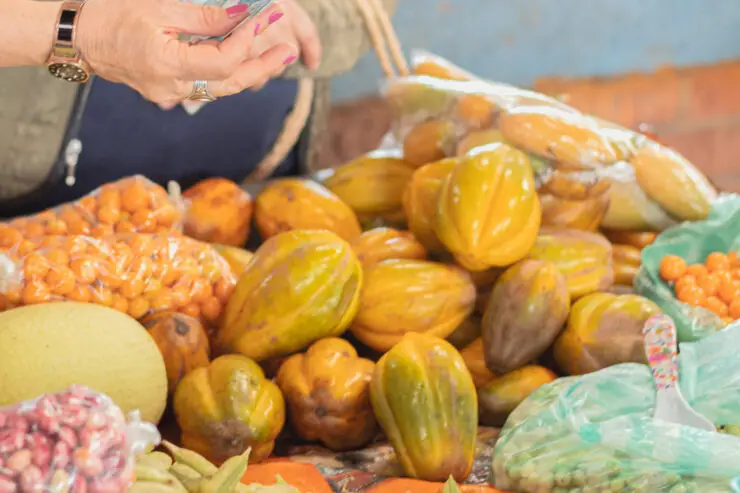As an Amazon Associate I earn from qualifying purchases. Please read the disclaimer for more info.
Chilean Papaya is one of my favorite exotic fruits. Whenever I travel to South America, I find my way to the local markets to secure a small piece of that unique sweet flavor of this delicious fruit.
This tropical fruit is one of many Chilean fruits providing various health benefits, from boosting immunity to aiding digestion.
The Chilean Papaya is juicy, sweet, and low in calories – the ideal snack for those looking to stay healthy and full! Its unique flavor makes it an excellent addition to any meal.
It can be eaten raw or cooked in various dishes like salads and smoothies.
What is Chilean Papaya


The Chilean Papaya, also known as Mountain Papaya, Vasconcellea pubescens, or Mountain PawPaw, is a unique variety of papaya that hails from the Andean valleys of Chile.
This exotic fruit is smaller than the common papaya (Carica papaya) and features an elongated shape with green to yellow skin.
Inside, you’ll find a vibrant orange fruit pulp that encases small, black seeds. The taste of mountain papayas are distinct— they’re less sweet than their tropical counterpart, with a mild flavor that’s often described as a cross between a melon and a berry
The Origin and Variations of Chilean Papaya
The Chilean Papaya is native to South America, particularly in the Andean regions spanning from Colombia to central Chile.
European explorers first discovered it during their expeditions in the 16th century. Over time, several variations of this fruit have developed, each with subtle differences in size, color, and flavor.
These include the Ecuadorian mountain papaya (Vasconcellea stipulata) and the highland papaya (Vasconcellea cundinamarcensis).
Cultivation and Harvesting Process

Chilean Papaya thrives in subtropical climates, particularly in the fertile soils of the Elqui Valley in Northern Chile, not too far from the towns of La Serena and Coquimbo.
The plant grows up to 15 feet tall and bears fruit year-round, although the peak harvesting period is from June through December.
Harvesting is typically done by hand to prevent damage to the delicate fruits.
Related: Delicious Chilean Cherries: Taste, Health Benefits, and Culinary Uses
Tasting the Chilean Papaya: Flavors and Culinary Uses
Taste and Texture
The taste of Chilean Papaya, or Mountain Papaya, is a unique blend of familiar fruit flavors. Descriptions often liken its taste to a mix of peach and mango, with others adding that it has a subtle hint of pear.
Some even describe the flavor as an elusive blend of pineapple, strawberry, and orange. The sweetness of the fruit is not overpowering, giving it a balanced, slightly musky taste.
Regarding texture, it’s been described as firm, similar to a peach or pear. This distinct combination of taste and texture makes Chilean Papaya a versatile ingredient in traditional and modern cuisine.
Culinary Uses
Traditionally, Chilean Papaya is enjoyed fresh as a snack or dessert. Its firm texture makes it perfect for salads, providing a sweet and tangy touch. It can also be used in smoothies, lending its unique flavor and health benefits to these refreshing drinks.
To eat the papaya, cut it in half and scoop out the seeds with a spoon. Then, either enjoy the pulp raw or cook it by adding sugar or honey for a sweet treat. You can also peel the skin and, after discarding the seeds, cut it into pieces ready for snacking.
Chilean Papaya has found its way into various dishes in modern culinary applications. Its unique taste enhances the flavor of both sweet and savory dishes.
For instance, it can be used in salsas, chutneys, and marinades for meats. The fruit’s natural sweetness makes it a great addition to desserts like pies, tarts, and ice cream.
Additionally, it is often preserved in syrup and exported for wider consumption. This allows the fruit to be enjoyed year-round and across the globe, introducing its distinctive flavor to more people.
Chilean Papaya’s Nutritional Profile and Health Benefits
Papayas are low in calories but high in essential nutrients. They contain approximately 59 calories per serving, with 15 grams of carbohydrates, 3 grams of fiber, and 1 gram of protein. They’re also rich in vitamins A, B, and C, making them a nutrient-dense addition to any diet.
Health Benefits of Consuming Chilean Papaya
- Digestive Health: The fruit is high in dietary fiber, which aids digestion by promoting regular bowel movements.
- Immune System Boost: The high Vitamin C content in Papaya supports immune health by helping to stimulate the production of white blood cells.
- Anti-Inflammatory Properties: Chilean Papaya contains antioxidants, flavonols, and carotenoids, which all reduce inflammation in the body.
- Rich in Antioxidants: The presence of Vitamins A and C, along with other antioxidants, helps combat oxidative stress, protecting cells from damage by free radicals.
It is a versatile fruit that can be easily incorporated into your diet. Enjoy it fresh as a snack, or add it to salads for a sweet and tangy touch. You could blend it into smoothies for a nutrient-packed breakfast or post-workout meal.
Healthline has a comprehensive review of the health benefits of Payaya.
Papaya Production: Importance to the Chilean Economy
The Chilean Papaya, or Mountain Papaya, plays a significant role in Chile’s local and national economy. The fruit is primarily grown in Central and Northern Chile, contributing to local agricultural activities and providing income for farmers and their communities.
Chile has a highly open economy, with international trade representing 64.4% of the country’s GDP in 2021.
The Chilean Papaya stands out as an important agricultural product in this landscape. While exact figures on the economic impact of this specific fruit are not readily available, it’s worth noting that Chile is the largest market in South America for U.S. consumer-oriented agricultural products, indicating a robust agricultural sector.
Moreover, Chile’s focus on export diversification policies has allowed it to leverage its agricultural resources, including fruits like the Chilean Papaya.
Thanks to Chile’s counter-seasonal harvest, consumers worldwide can enjoy Chilean fruits year-round, contributing to the country’s export revenues.
Major fruit exports include Chilean Apples, blueberries, and Cherries.
The major export markets for Chilean fruits include the United States, Europe, and Asia. These markets appreciate the quality and variety of Chilean produce, and the Chilean Papaya is no exception. Its unique taste and nutritional profile have made it popular in these regions.
Final Thoughts
Chilean Papaya is an exotic fruit that has been cultivated in Chile for many years. Its unique flavor, consisting of a blend of peach, mango, pineapple, and strawberry, makes it the perfect addition to sweet and savory dishes. It can be enjoyed in salads, smoothies, salsas, chutneys, and marinades and is often preserved in syrup and used for juices.
If you enjoyed this look at Chile’s Papaya, you might like one of these fruit-related articles:
- 11 Indian Summer Fruits to Quench Your Thirst and Beat the Heat
- 23 Exotic Chinese Fruits to Try on Your Travels
- Jackfruit vs. Durian: Similarities and Differences
- The Delicious Golden Hami Melon
- 19 African Fruits You Need to Try
Frequently Asked Questions
The Mountain Papaya is edible and can be eaten raw or cooked. It is often used in various dishes, including salads, smoothies, salsas, chutneys, and marinades. The sweet flavor of the fruit makes it ideal for preserving in syrup to make juices as well.
To eat Mountain Papaya, cut it in half and scoop out the seeds with a spoon. Then, either enjoy the pulp raw or cook it by adding sugar or honey for a sweet treat. You can also peel the skin and cut it into pieces for snacking.
Photo Credit: Michael Hermann, CC BY-SA 3.0 https://creativecommons.org/licenses/by-sa/3.0, via Wikimedia Commons

